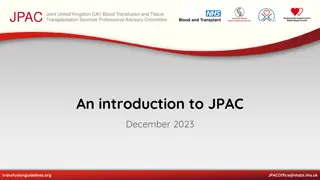Importance of Single Unit Red Blood Cell Transfusion According to Patient Blood Management Guidelines
Implementing single unit red blood cell transfusion based on patient blood management guidelines is crucial to minimize risks associated with transfusion, such as morbidity, mortality, and length of stay. By following these guidelines, healthcare providers can make informed decisions, reduce unnecessary transfusions, and improve patient outcomes. Adhering to the principles of transfusing one unit at a time, reassessing clinical symptoms, and focusing on patient well-being rather than just hemoglobin levels can lead to more effective and safe transfusion practices.
Download Presentation

Please find below an Image/Link to download the presentation.
The content on the website is provided AS IS for your information and personal use only. It may not be sold, licensed, or shared on other websites without obtaining consent from the author.If you encounter any issues during the download, it is possible that the publisher has removed the file from their server.
You are allowed to download the files provided on this website for personal or commercial use, subject to the condition that they are used lawfully. All files are the property of their respective owners.
The content on the website is provided AS IS for your information and personal use only. It may not be sold, licensed, or shared on other websites without obtaining consent from the author.
E N D
Presentation Transcript
Single Unit Transfusion for Red Blood Cell Transfusion Based on the Patient Blood Management Guidelines Every ONE matters
Patient Blood Management Guidelines www.blood.gov.au www.blood.gov.au/pbm-guidelines
Single Unit Transfusion WHO The stable, normovolaemic adult inpatient who does NOT have clinically significant bleeding with symptoms of anaemia Haemoglobin as defined in the Patient Blood Management Guidelines www.blood.gov.au/patient-blood-management
Every ONE matters WHAT Transfuse one unit, then reassess the patient for clinical symptoms before transfusing another Every unit is a new clinical decision Base decision on patient symptoms, not only on haemoglobin
Single Unit Transfusion WHY It is important to align practice with the national Patient Blood Management Guidelines Transfusion may be an independent risk factor for increased morbidity, mortality and length of stay. Potential harm from transfusion is dose dependent Transfusion is a live tissue transplant The British Committee for Standards in Haematology (2012). Guidelines on the Administration of Blood Components. Addendum to Administration of Blood Components, August 2012 pdf. http://www.bcshguidelines.com/4_HAEMATOLOGY_GUIDELINES.html Carson JL et al. 2012. Transfusion thresholds and other strategies for guiding allogeneic red blood cell transfusion Cochrane Review. Cochrane Database of Systematic Reviews 2012: Issue4 Hofmann A, Farmer S, Shander A. 2011. Five Drivers Shifting the paradigm from Product-focused Transfusion Practice to Patient Blood Management The Oncologist 2011;16(suppl 3):3-11 Hofmann, A et al. 2012. Strategies to preempt and reduce the use of blood products: an Australian perspective. Curr Opin Anesthesiol 2012, 25:66-73.
Four reasons why excessive transfusion is a problem Reason 1: Each transfusion increases the risk of nosocomial infection increases other morbidities Analysis of 11,963 patients after CABG surgery showed that perioperative RBC transfusion was associated with a dose-dependent increased risk of postoperative cardiac complications, serious infection, renal failure, neurologic complications, overall morbidity, prolonged ventilator support, and in-hospital mortality. Koch CG et al. Morbidity and mortality risk associated with red blood cell and blood-component transfusion in isolated coronary artery bypass grafting. Crit Care Med 2006, 34: 1608-1616.
Four reasons why excessive transfusion is a problem Reason 2: Transfusion requirements after cardiac surgery (TRACS) study prospectively demonstrated the safety of a restrictive strategy of red blood cell (RBC) transfusion in patients undergoing cardiac surgery. Also reported: the higher the number of transfused RBC, the higher was the number of clinical complications. Hajjar LA et al. Transfusion requirements after cardiac surgery: the TRACS randomised controlled trial. JAMA, 304:1559-1567.
Four reasons why excessive transfusion is a problem Reason 3: Transfusion associated circulatory overload (TACO) is among the high risk adverse effects of red cell transfusion (up to 1 in 100 per unit transfused). National Blood Authority, 2012. Patient Blood Management Guidelines: Module 2 - Perioperative. Appendix B, Table B.2.Transfusion Risks in perspective.
Four reasons why excessive transfusion is a problem Reason 4: Perioperative red blood cell transfusion is the single factor most reliably associated with increased risk of postoperative morbid events after isolated coronary artery bypass grafting. Each unit of red cells transfused is associated with incrementally increased risk for adverse outcome. Koch CG et al. Morbidity and mortality risk associated with red blood cell and blood-component transfusion in isolated coronary artery bypass grafting. Crit Care Med 2006, 34: 1608-1616.
Implementing a guideline Every ONE matters HOW Identify key staff / team responsible for implementation Approval and endorsement - CHAMPIONS From Transfusion Governance Committee / Patient Blood Management Committee Medical and nursing leadership Transfusion Medicine leadership
Implementing a Guideline Every ONE matters Implementation Hospital wide education; medical, nursing, laboratory staff, in all clinical areas that administer blood products Encourage clinical champions to spread the message Include in orientation education for new staff Key messages, visible signage, electronic media, newsletters.
Clinical Support is Vital Empower and Support Nursing and Laboratory staff who question the appropriateness of a request for blood must have: Documentation of the guideline outlining criteria for a second unit of blood Ready access to medical support - Champions to discuss episodes of apparent non-compliance Educational material to give to staff unaware of the guideline
Guiding Compliance Empower and support staff to question prescription / order for blood products Laboratory staff, nursing staff, medical staff Guideline accessible at prescription point and in laboratory including prompts for questions about compliance Inclusion criteria for second unit Prompt patients to enquire about blood transfusion requirements Support from clinical champions to resolve challenges to requests Utilise Computerised Physician Order Entry systems if available to guide transfusion decisions and compliance to the guideline
Collect and Report Data Data collection Statistics from laboratory systems: blood packs ordered daily from the Blood Service Daily transfusion numbers units, patients Number of single unit transfusions Log of non-compliant requests to laboratory / local Incident Management System Audit of patient medical record for transfusions *Please note: incidents, adverse events and near misses should continue to be recorded in your incident management system.
Report Data / Feedback Reporting Progress Feedback data To Transfusion Governance Committee, quality committee, clinical governance / executive Medical specialties / divisions, nursing meetings, laboratories. Benchmark between departments, hospitals, health services, states.
Review and Feedback Benchmark internally, locally, externally. Share statistics and reports with staff Provide a forum for discussion of difficulties, and seek resolutions to problems Provide access to articles / reports about progress and new developments in single unit transfusion Patient Blood Management
Every ONE matters Transfuse One Unit Re-assess the patient Don t increase the RISKS if NO BENEFIT
Single Unit Transfusion Guideline Benefits: Safer, evidence based transfusion PLUS: Reduced risk of non-infectious adverse events Reduced demand on limited blood supply Reduced risk from new infectious agents Every ONE matters























